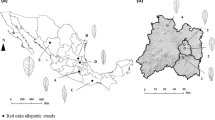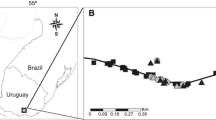Abstract
Natural hybridization between an insular endemic species and a widely distributed congener may endanger the endemic through genetic assimilation or outbreeding depression. Furthermore, hybrids can exhibit complex morphological variation, causing taxonomic problems in the identification of the involved taxa. In this work, we used a combination of leaf morphological and molecular markers (RAPD) to establish the differentiation between Psidium sp. aff. sartorianum and the insular endemic P. socorrense. It was also determined if hybridization between these taxa occurs in the southern slope of Isla Socorro, Mexico. Plant collection was carried along an altitudinal gradient (100–800 m). We collected eight populations separated 100 m a.s.l. apart from each other; 25 individuals were collected per population. Psidium socorrense and P. sp. aff. sartorianum differed significantly in all but two morphological characters measured. Also, a high number of diagnostic RAPD markers were found for each taxon. These results suggest that two Psidium species occur at Isla Socorro. Furthermore, both morphological and RAPD markers revealed a hybrid zone located in the southern slope of Isla Socorro (400–700 m a.s.l.) with an asymmetrical pattern of gene flow towards P. socorrense. We suggest that the disturbance caused by the sheep population in the mixed stand favors the establishment of hybrids. We further discuss whether hybridization represents a threat to the insular endemic P. socorrense.






Similar content being viewed by others
References
Anderson E (1948) Hybridization of the habitat. Evolution 2:1–9
Anderson E (1949) Introgressive hybridization. John Wiley, New York
Anton KA, Ward JR, Cruzan MB (2013) Pollinator-mediated selection on floral morphology: evidence for transgressive evolution in a derived lineage. J Evol Biol 26:660–673
Arnold ML (2006) Evolution through genetic exchange. Oxford University Press, New York
Barton NH (1992) On the spread of new gene combinations in the third phase of Wright’s shifting-balance. Evolution 46:447–551
Beatty GE, Philipp M, Provan J (2010) Unidirectional hybridization at a species’ range boundary: implications for habitat tracking. Divers Distrib 16:1–9
Brattstrom BH (1990) Biogeography of the Isles Revillagigedo, Mexico. J Biogeogr 17:177–183
Brennan AC, Bridle JR, Ai-Lan W, Hiscock SJ, Abbott RJ (2009) Adaptation and selection in the Senecio (Asteraceae) hybrid zone on Mount Etna, Sicily. New Phytol 183:702–717
Buerkle CA, Wolf DE, Rieseberg LH (2003) The origin and extinction of species through hybridization. In: Brigham CA, Schwartz MW (eds) Population viability in plants. Springer, Berlin, pp 117–141
Burguess KS, Morgan M, Deverno L, Husband BC (2005) Asymmetrical introgression between two Morus species (M. alba, M. rubra) that differ in abundance. Mol Ecol 14:3471–3483
Burguess KS, Morgan M, Husband BC (2007) Interspecific seed discounting and the fertility cost of hybridization in an endangered species. New Phytol 177:276–284
Caraway V, Carr GD, Morden CW (2001) Assessment of hybridization and introgression in lava-colonizing Hawaiian Dubautia (Asteraceae: Madiinae) using RAPD markers. Am J Bot 88:1688–1694
Carlquist S (1974) Island biology. Columbia University Press, New York
Chacón-Torres A, Villaroel MM, Zataray M, Carrillo MO, Corona JG, Chavarría MPG, Gutiérrez AH, Morales OR, Solorio MAA, Rivera R, Villegas RES (1993) Reconocimiento ecológico de la Isla Socorro, Archipiélago de Revillagigedo, Colima, México. Revista Universidad Michoacana 9:11–39
Crawford DJ, Witkus R, Stuessy TF (1987) Plant evolution and speciation on oceanic islands. In: Urbanska KM (ed) Differentiation patterns in higher plants. Academic Press, London, pp 183–199
Daehler C, Strong DR (1997) Hybridization between introduced smooth cordgrass (Spartina alterniflora; Poaceae) and native California cordgrass (S. foliosa) in San Francisco Bay, California, USA. Am J Bot 84:607–611
D’Andrea L, Felber F, Guadagnuolo R (2008) Hybridization rates between lettuce (Lactuca sativa) and its wild relative (L. serriola) under field conditions. Environ Biosaf Res 7:61–71
Dittrich-Reed DR, Fitzpatrick BM (2013) Transgressive hybrids as hopeful monsters. Evol Biol 40:310–315
Ellstrand NC, Biggs D, Kaus A, Lubinsky P, McDade LA, Preston K, Prince LM, Regan HM, Rorive V, Ryder OA, Schierenbeck KA (2010) Got hybridization? A multidisciplinary approach for informing science policy. Bioscience 60:384–388
Ellstrand NC, Elam DR (1993) Population genetic consequences of small population size: implications for plant conservation. Annu Rev Ecol Syst 4:217–242
Flores-Palacios A, Martínez-Gómez JE, Curry RL (2009) La vegetación de Isla Socorro, Archipiélago de Revillagigedo, México. Bol Soc Bot Mex 84:13–23
Gaskin JF, Schaal BA (2002) Hybrid Tamarix widespread in US invasion and undetected in native Asian range. Proc Natl Acad Sci USA 99:11256–11259
González-Pérez MA, Caujapé-Castells J, Sosa PA (2004) Molecular evidence of hybridisation between the endemic Phoenix canariensis and the widespread P. dactylifera with Random Amplified Polymorphic DNA (RAPD) markers. Plant Syst Evol 247:165–175
González-Pérez MA, Sosa PA (2009) Hybridization and introgression between the endemic Phoenix canariensis and the introduced P. dactylifera in the Canary Islands. Open For Sci J 2:78–85
Hardig TM, Brunsfeld SJ, Fritz RS, Morgan M, Orians CM (2000) Morphological and molecular evidence for hybridization and introgression in a willow (Salix) hybrid zone. Mol Ecol 9:9–24
Hedge SG, Nason JD, Clegg JM, Ellstrand NC (2006) The evolution of California’s wild radish has resulted in the extinction of its progenitors. Evolution 60:1187–1197
Hoban SM, McCleary Schlarbaum E, Anagnostakis SL, Romero-Severson J (2012) Human-induced landscapes facilitate hybridization between a native and an introduced tree. Evol Appl 5:720–731
Holman JS, Hughes JM, Fensham RJ (2003) A morphological cline in Eucalyptus: a genetic perspective. Mol Ecol 12:3013–3025
Howard DJ, Preszler RW, Williams J, Fenchel S, Boecklen WJ (1997) How discrete are oak species? Insights from a hybrid zone between Quercus grisea and Q. gambelli. Evolution 5:747–755
Johnston MI (1931) The Flora of the Revillagigedo II. Proc Calif Acad Sci 20:9–104
Judd WS, Campbell CS, Kellogg EA, Stevens PF, Donoghue MJ (2002) Plant Systematics, a phylogenetic approach. Sinauer Associates, Massachusetts
Levin DA (2000) The origin, expansion, and demise of plant species. Oxford University Press, New York
Levin DA, Francisco-Ortega J (1996) Hybridization and the extinction of rare plant species. Conserv Biol 10:10–16
Levin G, Moran R (1989) The vascular flora of Socorro Island, Mexico. San Diego Society of Natural History 16:1–71
Liston A, Rieseberg LH, Mistretta O (1990) Ribosomal DNA evidence for hybridization between island endemic species of Lotus. Biochem Syst Ecol 18:239–244
Losos JB, Ricklefs RE (2009) Adaptation and diversification on islands. Nature 457:830–836
Mallet J (2005) Hybridization as an invasion of the genome. Trends Ecol Evol 20:229–237
Martínez-Gómez JE, Curry RL (1996) The conservation status of the Socorro Mockingbird Mimodes graysoni in 1993–1994. Bird Conserv Int 6:271–283
Mayr E (1942) Systematics and the origin of species from the viewpoint of a zoologist. Columbia University Press, New York
Meyerson LA, Viola DV, Brown RN (2010) Hybridization of invasive Phragmites australis with a native subspecies in North America. Biol Invasions 12:103–111
Miranda F (1960) Vegetación. In: Adem J, Cobo E, Blázquez L, Miranda F, Villalobos A, Herrera T, Villa B, Vázquez L (eds) La isla Socorro, Archipiélago de las Revillagigedo. Monografías del Instituto de Geofísica. UNAM, México, pp 201–216
Mondini L, Noorani A, Pagnotta MA (2009) Assessing plant genetic diversity by molecular tools. Diversity 1:19–35
Paulay G (1994) Biodiversity on oceanic islands: Its origin and extinction. Am Zool 34:134–144
Ramírez-Rodríguez R, Tovar-Sánchez E, Jiménez Ramírez J, Vega Flores K, Rodríguez V (2011) Introgressive hybridization between Brahea dulcis and Brahea nítida (Arecaceae) in Mexico: evidence from morphological and PCR-RAPD patterns. Botany 89:545–557
Randell RA, Howarth DG, Morden CW (2004) Genetic analysis of natural hybrids between endemic and alien Rubus (Rosaceae) species in Hawai’i. Conserv Genet 5:217–230
Rieseberg LH, Archer MA, Wayne RK (1999) Transgressive segregation, adaptation, and speciation. Heredity 83:363–372
Rieseberg LH, Carney SE (1998) Plant hybridization. New Phytol 140:599–624
Rieseberg LH, Ellstrand NC (1993) What can morphological and molecular markers tell us about plant hybridization? Crit Rev Plant Sci 12:213–241
Rieseberg LH, Gerber D (1995) Hybridization in the Catalina Island mountain mahogany (Cercocarpus traskiae): RAPD’s evidence. Conserv Biol 9:199–203
Salas-Pascual M, Acebes-Ginoves JR, Del Arco Aguilar M (1993) Arbutus × androsterilis, a new interspecific hybrid between A. canariensis and A. unedo from the Canary Islands. Taxon 42:789–792
Schwarzbach AE, Donovan LA, Rieseberg LH (2001) Transgressive character expression in a hybrid sunflower species. Am J Bot 88:270–277
Seehausen O, Takimoto G, Roy D, Jokela J (2008) Speciation reversal and biodiversity dynamics with hybridization in changing environments. Mol Ecol 17:30–44
Shasany AK, Darokar MP, Dhawan S, Gupta AK, Gupta S, Shukla AK, Patra NK, Khanuja SPS (2005) Use of RAPD and AFLP markers to identify inter- and intraspecific hybrids of Mentha. J Hered 96:542–549
Stace CA (1975) Hybridization and the flora of the British Isles. Academic Press, London
Tovar-Sánchez E, Rodríguez-Carmona F, Aguilar-Mendiola V, Mussali-Galante P, López-Caamal A, Valencia-Cuevas L (2012) Molecular evidence of hybridization in two native invasive species: Tithonia tubaeformis and T. rotundifolia (Asteraceae) in Mexico. Plant Syst Evol 298:1947–1959
Triest L, de Greef B, De Bondt R, van Slyckenà J (2000) RAPD of controlled crosses and clones from the field suggests that hybrids are rare in the Salix alba-Salix fragilis complex. Heredity 84:555–563
van Hengstum T, Lachmuth S, Oostermeijer JGB, den Nijs HCM, Meirmans PG, van Tienderen PH (2012) Human-induced hybridization among congeneric endemic plants on Tenerife, Canary Islands. Plant Syst Evol 298:1119–1131
Vilà M, Weber E, D’Antonio CM (2010) Conservation implications of invasion by plant hybridization. Biol Invasions 2:207–217
Walter HS, Levin GA (2008) Feral sheep on Socorro Island: facilitators of alien plant colonization and ecosystem decay. Divers Distrib 14:422–431
Whitney KD, Ahern JR, Campbell LG, Albert LP, King MS (2010) Patterns of hybridization in plants. Perspect Plant Ecol 12:175–182
Williams JGK, Kubelik AR, Livak KL, Rafalski JA, Tingey SV (1990) DNA polymorphisms amplified by arbitrary primers are useful as genetic markers. Nucleic Acids Res 18:6531–6535
Wilson P (1992) On inferring hybridity from morphological intermediacy. Taxon 41:11–23
Wolf DE, Takebayashi N, Rieseberg LH (2001) Predicting the risk of extinction through hybridization. Conserv Biol 15:1039–1053
Yüzbaşıoğlu E, Dadandı MY, Özcan S (2008) Natural hybridization between Phlomis lycia D. Don × P. bourgaei Boiss., (Lamiaceae) revealed by RAPD markers. Genetica 133:13–20
Zar JH (2010) Biostatistical analysis. Prentice Hall, New Jersey
Zha XF, Srirama RD, Fernandez MG, Mistree F (2008) Knowledge-intensive collaborative decision support for design processes: A hybrid decision support model and agent. Comput Ind 59:905–922
Acknowledgments
We thank Maribel Paniagua Ibañez, Leonardo Beltrán, Paulette Arellano Vignettes, Guadalupe Rangel Altamirano, L. Márquez Valdemar, and Elgar Castillo Mendoza for technical assistance. We also thank Mauricio Mora Jarvio for his field assistance and Ramiro Cruz-Durán for providing excellent Psidium illustrations.
Author information
Authors and Affiliations
Corresponding author
Electronic supplementary material
Below is the link to the electronic supplementary material.
606_2014_1025_MOESM1_ESM.doc
Supplementary material Phenotype characterization (Schwarzbach et al. 2001) of 17 leaf morphological characters in mixed stands between Psidium sp. aff. sartorianum and P. socorrense in Socorro Island, Mexico. (DOC 143 kb)
Rights and permissions
About this article
Cite this article
López-Caamal, A., Cano-Santana, Z., Jiménez-Ramírez, J. et al. Is the insular endemic Psidium socorrense (Myrtaceae) at risk of extinction through hybridization?. Plant Syst Evol 300, 1959–1972 (2014). https://doi.org/10.1007/s00606-014-1025-9
Received:
Accepted:
Published:
Issue Date:
DOI: https://doi.org/10.1007/s00606-014-1025-9




